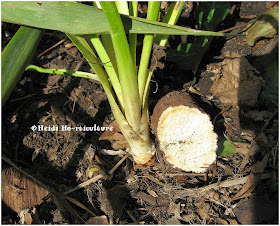 |
| Frustration kicks in every spring when it comes to grass lawns. |
Brown grass - having died from dog urine, salt damage along walkways, grub damage, snow mould causing root fungus, crab-grass removal making bare spots....ok, repairing the lawn is getting tiresome.
What to do.
Given this is the right time of year and it is going to rain in the next two days, this is how we went about it:
First, we dealt with the sad looking turf. We mowed the lawn at the lowest setting, without scalping the turf. Then we de-thatched the grass lawn by raking it thoroughly.
 |
| We raked out about 3 of these large containers full. Even removing some green blades of grass to make sure soil is exposed. |
Any bare spots, we removed dead grass completely, and loosened (aerated) the soil beneath with a garden fork. The ground beneath is fairly moist, given it rained a day or two earlier. This is key. Clover seed requires adequate moisture for germination.
We purchased soil in bags. We checked local flyers for deals on bagged top soil. Pays to shop around. The bagged soil has no weed seeds. Enough said. Worth the extra expense IMO. Try not to use fluffy soil. Add sand to peat based soils.
Any bare turf pockets, we back filled with soil and raked it into the existing grass.
Leveling the ground as we raked. The bare spots had over 1-2 inches of top soil.
 |
| If you have access to a sod roller, use it. We just gently walked over
the new top soil - trampling it down with foot traffic. Our bare patches
didn't warrant a roller rental. It's important to tamp down the soil - it prevents soil
from washing or blowing away during inclement spring weather. |
We top-dressed the remaining healthy grass with soil and raked it in thoroughly. We desire to have both grass and clover to thrive.
Various Clover Seed lawn instructions mentioned that the best way to overseed clover in smaller areas is to incorporate and mix the seed with soil before applying.
 |
| Clover seed is similar looking to mustard seed. It's quite
tiny and to seed directly by hand, would cause too much concentration
in some spots vs others. |
This bag can cover over 2000sq ft. Our area was about 900sq ft. We used half a bag worth of seed. Took a wheelbarrow, added 30L bag of top soil and mixed the seed thoroughly.
 |
| Cutting an old jug like this - to make a scoop, we over-seeded the mixture on to the bare spots first. |
 |
| Sprinkling it as even as possible. |
 |
| I again gently trampled the sprinkled mixture on the bare spots and then took a corn broom and swept over the areas. |
Do not rake the seed in. Raking would disturb the newly placed soil beneath. Sweep instead. This is far more gentler and just as effective. The sweeping pressure makes sure the seeds stick well and go just below the soil level. For best results, White Clover seeds should not be sown deeper than 1/4 inch or 1cm beneath the soil. Mixing it with soil and spreading them together allows good coverage without over burying the seed.
Once the bare spots were over-seeded, we sprinkled the soil/seed mix rather sparingly over the grass.
To make sure the seed gets in between the grass, down to the soil level, we fan raked the turf thoroughly. Our expectation is to see clover pop up between the grass, eventually overtaking the grass once it gains vigor.
With the last bag of soil, we lightly top dressed the lawn over the seed. Being more generous with bare pockets. Just enough to cover the seed.
 |
| Just use your fingers to flick the soil sharply and it will scatter quite evenly. |
Water in gently. Don't use harsh spray or sprinklers that soak, creating puddles. A gentle shower that wets the soil is sufficient. Try planning this job around pending rain. Not stormy rain, but good lengthy rain. Clover seed needs moisture to germinate. Don't let it dry out. It takes 7-10 days for germination success.
 |
| All done. |
Why White Clover? Clover is fairly deep rooted and more durable. It's more tolerant to urine, to salt, to drought and to foot traffic. Clover spreads rapidly by creeping stolons, for good coverage. It stays green during drought laden summers. It also fixates nitrogen with Rhizobium bacteria that grows along their roots. White Clover self seeds when allowed to flower. You'll need to mow and irrigate less often.
Note: It also attracts bees. For some this may be a deterrent, but with declining bee populations, we welcome them to our landscape.
Let's hope it works out.
Will update on progress and durability. (
Update completed)
Please look at my blog's left panel for more alternative lawn choices.











































